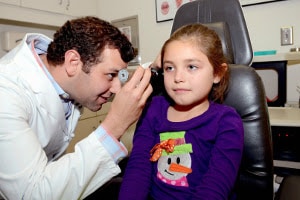Do you feel like you are constantly repeating yourself to your child or having to speak loudly to get their attention? In many cases, kids are being kids and using selective hearing with their parents, but hearing loss can also be a concern. Hearing loss is a condition in which the ears no longer work properly, the ability to hear has been lost, the sound is not heard as clearly, or it is heard after a delay.
It can be challenging to navigate a diagnosis and treatment options when your child has hearing difficulties. The best place to start is with a board-certified and experienced pediatric ENT to learn more about hearing loss and the next steps.
Why and when does hearing loss occur?
Hearing loss in children is not a one-size-fits-all diagnosis. The ear is a complex design with many contributing factors to hearing loss, including:
Otitis Media
Otitis Media is the inflammation in the ear behind the eardrum typically caused by fluid. It can result in symptoms and severity ranging from decreased hearing to permanent hearing loss. Otitis Media is common in young children because the passage between the middle ear and back of the throat is smaller and can be blocked more easily. When fluid is present in the middle ear, vibrations from the eardrum are not transmitted correctly and can make sounds or speech muffled.
Congenital Causes
Congenital hearing loss means that hearing loss was identifiable at birth and can include hereditary or genetic factors, prenatal infections, and other conditions. Some genetic causes include:
- Autosomal dominant hearing loss: One parent has a dominant gene for hearing loss and typically has hearing loss that is passed onto the child.
- Autosomal recessive hearing loss: Both parents with normal hearing have a recessive gene that is passed onto the child.
- X-linked hearing loss: The mother has the recessive gene on the sex chromosome, which can be passed onto male children, not female ones.
Acquired Causes
This type of hearing loss can occur at any point in life and can be a result of injury, illness, or a medical condition. Some causes include:
- Ear infections
- Meningitis
- Exposure to loud noise
- Mumps and measles
Common Signs of Hearing Loss
Hearing loss is complex because it does not always relate to volume but also to pitch loss. For example, some children cannot hear high frequencies but can hear low sounds very well. Hearing loss in high frequencies can mean struggling to understand speech but identifying a helicopter flying nearby. Signs of hearing loss can differ in babies versus school-age children. Some signs for school-age children can include:
- Difficulty understanding people talking
- Delayed speech or nonresponsive to others
- Difficulty forming words
- Turning the volume up high on the TV or radio
- Ear pain, hearing noises
- Academic struggles that were not present before an illness or injury
- Needing to see the speaker’s mouth to understand the speech
Signs of hearing loss in infants and toddlers include:
- Doesn’t startle at loud noises
- Does not respond to your voice or other sounds
- Does not turn head toward sounds like music or enjoy toys that make noise
- Does not make babbling or cooing noises
- Cannot repeat sounds
- Cannot follow commands or listen to songs or books
Hearing Tests
If you are concerned about your child’s hearing, you can schedule an evaluation to determine the type and extent of the hearing loss. Some tests are based on age, while others can be performed based on level of understanding.
Hearing Tests for Babies and Toddlers
- Behavioral audiometry (babies): A screening that watched behavior to sounds
- Play audiometry: An electrode machine sends sounds at different pitches and volumes through headphones to see what, if anything, a child can hear.
- Visual reinforcement audiometry (VRA): A child is asked to move toward a source of sound and rewarded with visual reinforcement like a flashing or moving toy.
Hearing Tests for Older Children
- Pure tone audiometry: A test that makes sounds in various volumes and pitches with headphones, while the audiologist asks the child to respond when the sound can be heard.
- Tympanometry: This test screens the middle ear but does not determine if the child is hearing or not. It can identify pressure changes in the middle ear, leading to a more conclusive diagnosis.
Treatment Options for Hearing Loss in Children
Much like diagnosing hearing loss, the treatments can vary based on the severity and cause of hearing loss in a child. Some treatments can include:
- Hearing aids: A device that helps make sounds clear.
- Cochlear implants: A surgically implanted device that uses electrical stimulation to engage the auditory nerve.
- Speech therapy: If hearing loss has impacted speech, therapy can help with delays and strengthen understanding.
- Assistive listening devices: These work with hearing aids or cochlear implants that help eliminate background noise and improve acoustics. A teacher or speaker can wear the device to transmit sound more directly to the hearing impaired child.
Schedule a Hearing Evaluation for Your Child in Birmingham Today
Pediatric ENT Associates at Children’s of Alabama specializes in the diagnostic, medical, and surgical care of head and neck diseases in infants and children. Our expert physicians are board-certified, licensed in Alabama, and active in research and publications. Contact us to schedule a consultation and learn more about hearing loss in children.


